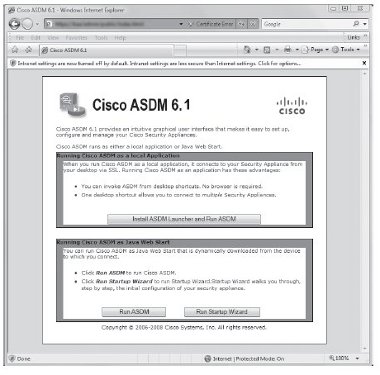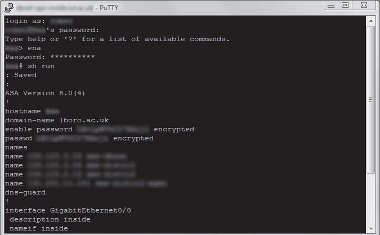SSL VPN Configuration of a Cisco ASA 8.0
The Cisco® ASA family of devices are based on the Cisco® PIX platform (Figure 19); however they have been re-engineered and improved with feature rich functions. Included in the ASA Platform is IPSec VPN, SSL VPN, Web Portal and Secure Desktop facilities. The IPSec VPN functions are included for no extra charge; the remainder are chargeable options after version 7.0 of the ASA.
Configuration of the Cisco ASA can be either through the CLI (command line interface) using SSH or through the ASDM GUI interface. The ASDM client software for Windows and Mac OS X operating systems is stored on the Cisco ASA and may be downloaded and installed by connecting to the ASA using HTTPS (Figure 20). Not all features of the ASA are supported through the GUI and vice versa through the CLI.
Figure 20. Cisco ASDM download and installation.
The CLI interface can be reached through the SSH protocol, typically using PuTTY under Windows (Figure 21) or SSH/Slogin on Unix/Linux Operating Systems.
Figure 21. Cisco ASA access through the CLI using PuTTY.
Configuration Example
The diagram below shows the interface names, IP ranges and functions.
The following configuration example configures the Cisco ASA for IPSec and SSL VPN connectivity, and provides pointers to areas mentioned in the SSL VPN chapter.
1. Configure the interfaces on the ASA for connectivity on the organisational LAN. Security levels should be configured so the inside interface is a higher value than the outside. Add default routes:
interface GigabitEthernet0/0
description inside
nameif inside
security-level 100
ip address 172.16.1.100 255.255.255.0
!
route inside 172.16.0.0 255.255.0.0 172.16.1.1.1
route inside 192.168.1.0 255.255.255.0 172.16.1.1.1
2. Clear the ASA flash and upload new firmware images:
show flash:
erase flash:
copy tftp://<tftp Server>/asa803-6-k8.bin flash:
copy tftp://<tftp Server>/asdm-611.bin flash:
3. Configure the new images as the default boot images:
boot system disk0:/asa803-6-k8.bin
asdm image disk0:/asdm-611.bin
wr mem
reload
4. Configure the ASA with appropriate passwords:
enable password -password-
passwd -password-
5. Enable SSH on the inside interface:
crypto key generate rsa modulus 1024
ssh 172.16.0.0 255.255.0.0 inside
ssh 172.16.1.0 255.255.255.0 management
ssh timeout 5
ssh version 2
Check with ssh <IP Address> -l pix
6. Configure other Interfaces and Routing:
interface GigabitEthernet0/1
description outside
no shutdown
nameif outsidesecurity-level 0
ip address 10.0.1.100 255.255.255.0
!
interface GigabitEthernet0/2
shutdown
no nameif
no security-level
no ip address
!
interface GigabitEthernet0/3
shutdown
no nameif
no security-level
no ip address
!
interface Management0/0
description management
no shutdown
nameif management
security-level 100
ip address 172.16.1.0 255.255.255.0
management-only
!
route outside 0.0.0.0 0.0.0.0 10.0.1.1.1
7. Configure DNS:
dns domain-lookup inside
dns server-group DefaultDNS
name-server <Primary DNS IP Address>
name-server <Secondary DNS IP Address>
name-server <Tertiary DNS IP Address>
domain-name camford.ac.uk
names
name <IP Address> <Static FQDN>
etc...
dns-guard
8. The ASA can categorise entities into object groups. Adding hostnames for entries within the configuration can make administration easier; in this example entries for Microsoft SMS Server are added:
object-group service MSRDP tcp
port-object eq 3389
object-group network SMS_Servers
network-object host sms-server1
network-object host sms-server2
network-object host sms-database
9. Create the Access Lists to support the security of the VPN/Firewall within the ACL:
access-list CAMFORD-NETBLOCKS-v1 standard permit 172.16.0.0 255.255.0.0
access-list CAMFORD-NETBLOCKS-v1 standard permit 192.168.1.0 255.255.255.0
access-list CAMFORD-NETBLOCKS-v1 standard deny any
access-list ANY-TO-ANY extended permit ip any any log critical
access-list CAMFORD-CENTRAL-SERVICES-v1 extended permit ip any 172.16.1.0 255.255.255.0
access-list CAMFORD-CENTRAL-SERVICES-v1 extended permit ip any 172.16.16.0 255.255.255.0
access-list CAMFORD-CENTRAL-SERVICES-v1 extended permit tcp any any eq ssh log alerts
access-list CAMFORD-CENTRAL-SERVICES-v1 extended permit tcp any any object-group MSRDP log alerts
access-list inside_nat0_outbound extended permit ip any 172.16.154.0 255.255.254.0 log critical
access-list Split_Tunnel_List remark allow only our traffic
access-list Split_Tunnel_List standard permit 172.16.0.0 255.255.0.0
access-list Split_Tunnel_List standard permit 192.168.1.0 255.255.255.0
access-list CAMFORD_splitTunnelAcl standard permit 172.16.0.0 255.255.0.0
access-list CAMFORD_splitTunnelAcl standard permit 192.168.1.0255.255.255.0
access-list CAMFORD-NOSMS extended deny tcp any object-group SMS_Servers eq www log alerts
access-list CAMFORD-NOSMS extended deny tcp any object-group SMS_Servers eq https log alerts
10. Configure the logging options:
logging enable
logging timestamp
logging console critical
logging buffered warnings
logging trap informational
logging asdm informational
logging facility 16
logging device-id hostname
logging host inside <IP Address of SYSLOG Server>
11. Configure MTU size and ICMP:
mtu inside 1500
mtu outside 1500
mtu management 1500
icmp unreachable rate-limit 1 burst-size 1
icmp permit 172.16.0.0 255.255.0.0 inside
icmp permit 192.168.1.0 255.255.255.0 inside
icmp permit 10.0.1.0 255.255.255.0 outside
12. Configure IP Address Local Pool and NAT:
ip local pool CAMFORD-LOCAL-POOL-v1 172.16.150.20-172.16.151.253 mask 255.255.254.0
nat (inside) 0 access-list inside_nat0_outbound
nat (inside) 0 0.0.0.0 0.0.0.0
static (inside,outside) 0.0.0.0 0.0.0.0 netmask 0.0.0.0
13. Configure the ASA Timeout values:
timeout xlate 3:00:00
timeout conn 1:00:00 half-closed 0:10:00 udp 0:02:00 icmp 0:00:02
timeout sunrpc 0:10:00 h323 0:05:00 h225 1:00:00 mgcp 0:05:00 mgcp-pat 0:05:00
timeout sip 0:30:00 sip_media 0:02:00 sip-invite 0:03:00 sip-disconnect 0:02:00
timeout uauth 0:05:00 absolute
14. Configure LDAP Attribute Map, to map LDAP attributes to meaningful names:
ldap attribute-map AD-Group-Mapping
map-name memberOf IETF-Radius-Class
map-value memberOf CN=maths,OU=groups,OU=SCIENCE,DC=camford,DC=ac,DC=uk mathsstaff
15. Configure Dynamic Access Policies to be applied depending on LDAP attributes:
dynamic-access-policy-record DfltAccessPolicy
network-acl CAMFORD-CENTRAL-SERVICES-v1
network-acl CAMFORD-NOSMS
dynamic-access-policy-record CAMFORD-DAP-MATHSSTAFF-v1
network-acl CAMFORD-MATHSSTAFF-v1
network-acl CAMFORD-CENTRAL-SERVICES-v1
network-acl CAMFORD-NOSMS
16. Enable WebServer:
http server enable
http 0.0.0.0 0.0.0.0 outside
http 172.16.0.0 255.255.0.0 inside
http 172.16.1.0 255.255.255.0 management
http redirect outside 80
http redirect inside 80
17. Configure SNMP:
snmp-server host inside <SNMP Monitoring IP> community public version 2c
snmp-server host inside <SNMP Monitoring IP> community public version 2csnmp-server location <LOCATION>
snmp-server contact <EMAIL>
snmp-server community <COMMUNITY>
snmp-server enable traps snmp authentication linkup linkdown coldstart
18. Crypto Map configuration is entirely dependent on the cryptography features required. The cryptomap command in the Cisco ASA allows the configuration of the cryptography features outlined in section 5.5.4 with specific reference to FIPS 140-2 Compliance.
19. IDS: Configure the basic, built-in IDS code:
threat-detection basic-threat
threat-detection statistics
20. NTP:
ntp server <IP of Server1> source inside prefer
ntp server <IP of Server2> source inside
21. WebVPN Configuration can be implemented in as little as eight stages. Section 8.2 explores web-based portals in more detail:
webvpn
enable outside
http-proxy <Web Proxy IP> 3128
https-proxy <Web Proxy IP> 3128
svc enable
smart-tunnel list "RDP_SSH" "PuTTY" "putty.exe"
smart-tunnel list "RDP_SSH" "MSRDP" "mstsc.exe"
22. Configure the default VPN Group Policy:
group-policy DfltGrpPolicy attributes
downtime messages etc. NOT the AUP!
wins-server value <WINS IP – If Required>
dns-server value <DNS Server1> <DNS Server2>
vpn-tunnel-protocol IPSec l2tp-ipsec svc webvpn
password-storage enable
ip-comp enable
re-xauth enable
pfs enable
ipsec-udp enable
split-tunnel-policy tunnelspecified
split-tunnel-network-list value Split_Tunnel_List
default-domain value camford.ac.uk
secure-unit-authentication enable
user-authentication enable
user-authentication-idle-timeout none
backup-servers clear-client-config
address-pools value CAMFORD-LOCAL-POOL-v1
webvpn
url-list value Camford
smart-tunnel enable RDP_SSH
file-entry disable
file-browsing disable
23. Configure the VPN Tunnel Groups:
tunnel-group DefaultRAGroup general-attributes
address-pool CAMFORD-LOCAL-POOL-v1
authentication-server-group CAMFORD-AD-v1
strip-realm
tunnel-group DefaultRAGroup webvpn-attributes
nbns-server <WINS Server> timeout 2 retry 2
nbns-server <WINS Server2> timeout 2 retry 2
tunnel-group DefaultRAGroup ipsec-attributes
pre-shared-key <SHARED SECRET>
tunnel-group DefaultWEBVPNGroup general-attributes
address-pool CAMFORD-LOCAL-POOL-v1
authentication-server-group CAMFORD-AD-v1
strip-realm
tunnel-group DefaultWEBVPNGroup webvpn-attributescustomization CAMFORD-HOMEPAGEv1
nbns-server <WINS Server> timeout 2 retry 2
nbns-server <WINS Server2> timeout 2 retry 2
group-alias Default enable
tunnel-group DefaultWEBVPNGroup ipsec-attributes
pre-shared-key <SHARED SECRET>
address-pool CAMFORD-POOL-v1
authentication-server-group CAMFORD-AD-v1
strip-realm
tunnel-group CAMFORD type remote-access
tunnel-group CAMFORD general-attributes
address-pool CAMFORD-LOCAL-POOL-v1
authentication-server-group CAMFORD-AD-v1
default-group-policy CAMFORD
tunnel-group CAMFORD ipsec-attributes
pre-shared-key <SHARED SECRET>
24. Configure a default Class Map for inspection:
class-map inspection_default
match default-inspection-traffic
25. Configure an inspection Policy Map:
policy-map type inspect dns preset_dns_map
parameters
message-length maximum 512
policy-map global_policy
class inspection_default
inspect dns preset_dns_map
inspect ftp
inspect h323 h225
inspect h323 ras
inspect netbios
inspect rsh
inspect rtsp
inspect skinny
inspect esmtp
inspect sqlnet
inspect sunrpc
inspect tftp
inspect sip
inspect xdmcp
policy-map type inspect dns migrated_dns_map_1
parameters
message-length maximum 512
26. Configure TACAS+ and default usernames if required:
aaa-server CAMFORD-TACACS-v1 protocol tacacs+
reactivation-mode timed
max-failed-attempts 5
aaa-server CAMFORD-TACACS-v1 host <TACACS SERVER1>
key <SHARED SECRET>
aaa-server CAMFORD-TACACS-v1 host <TACACS SERVER2>
key <SHARED SECRET>
aaa authentication enable console CAMFORD-TACACS-v1 LOCAL
aaa authentication http console CAMFORD-TACACS-v1 LOCAL
aaa authentication ssh console CAMFORD-TACACS-v1 LOCAL
aaa authentication serial console CAMFORD-TACACS-v1 LOCAL
aaa accounting enable console CAMFORD-TACACS-v1
aaa accounting serial console CAMFORD-TACACS-v1
aaa accounting ssh console CAMFORD-TACACS-v1
aaa accounting command CAMFORD-TACACS-v1
aaa authorization exec authentication-server
aaa authorization command CAMFORD-TACACS-v1 LOCAL
To verify that the device is in communication with the AAA server use the following command:
show aaa-server
27. Configure Active Directory LDAP authentication:aaa-server CAMFORD-AD-v1 protocol ldap
aaa-server CAMFORD-AD-v1 host <Domain Controller 1>
ldap-base-dn DC=camford,DC=ac,DC=uk
ldap-scope subtree
ldap-naming-attribute sAMAccountName
ldap-login-password <PASSWORD>
ldap-login-dn <Role Based AD Account>
server-type microsoft
ldap-attribute-map AD-Group-Mapping
aaa-server CAMFORD-AD-v1 host <Domain Controller 2>
ldap-base-dn DC=camford,DC=ac,DC=uk
ldap-scope subtree
ldap-naming-attribute sAMAccountName
ldap-login-password <PASSWORD>
ldap-login-dn <Role Based AD Account>
server-type microsoft
ldap-attribute-map AD-Group-Mapping
aaa-server CAMFORD-AD-v1 host <Domain Controller 3>
ldap-base-dn DC=camford,DC=ac,DC=uk
ldap-scope subtree
ldap-naming-attribute sAMAccountName
ldap-login-password <PASSWORD>
ldap-login-dn <Role Based AD Account>
server-type microsoft
ldap-attribute-map AD-Group-Mapping
28. The Cisco ASA requires an SSL VPN license to allow more than two SSL VPN sessions:
1. Go to: http://www.cisco.com/go/license
2. Enter the SSL VPN Product Authorisation Key (PAK) found on the License Claim Certificate.
3. Select [All Done]
4. Enter Serial Number from a ‘sh ver | include Number’ [Submit]
5. [Submit]
6. Once Registration is complete, await email confirmation.
7. ciscoasa(config)# activation-key [key from email]
29. Once the VPN has been configured the Network Connect AnyConnect Images need to be uploaded:
1. Start the ASDM and connect to the ASA
2. Configuration -> Remote Access VPN -> Network (Client) Access -> AnyConnect Connection Profiles
3. Select Access Interfaces: Enable Cisco AnyConnect VPN Client
4. Upload an AnyConnect Image
5. Configuration -> Remote Access VPN -> Network (Client) Access -> Advanced -> SSL VPN -> Client Settings
6. Click +Add
7. anyconnect-win-2.3.0185-k9.pkg
8. anyconnect-macosx-i386-2.3.0185-k9.pkg
9. anyconnect-macosx-powerpc-2.3.185-k9.pkg
10. anyconnect-linux-2.3.185-k9.pkg
30. The ASA can have a number of Client-Server Plugins for the Web-based VPN portal:
1. Start the ASDM and connect to the ASA
2. Configuration -> Remote Access VPN -> Clientless SSL VPN Access -> Portal -> Client-Server Plug-ins
3. Click +Import
4. Plug-in Name: RDP
5. Remote Server tftp://<SERVER>/ASA/ASAPlugin/rdp-plugin.080130.jar
6. Click +Import
7. Plug-in Name: SSH,Telnet
8. Remote Server tftp://<SERVER>/ASA/ASAPlugin/ssh-plugin.jar
9. Click +Import
10. Plug-in Name: SSH,Telnet
11. Remote Server tftp://<SERVER>/ASA/ASAPlugin/vnc-plugin.080130.jar
28. Finally Miscellaneous configuration:pager lines 24
ftp mode passive
arp timeout 14400
no failover
no vpn-addr-assign aaa
no vpn-addr-assign dhcp
telnet timeout 5
console timeout 0
l2tp tunnel hello 30
service-policy global_policy global
prompt hostname context
no asdm history enable
Further Documentation
Cisco provides more detailed documentation at the following locations:
- Command Line Configuration Guide (v8.0): http://www.cisco.com/en/US/docs/security/asa/asa80/configuration/guide/asa80cfg.pdf
- ASDM User Guide (v6.0): http://www.cisco.com/en/US/docs/security/asa/asa80/asdm60/user/guide/asdmug.pdf
- SSL VPN Certificates: http://www.cisco.com/warp/public/471/asa_8.x_3rdpartyvendorcert.pdf








